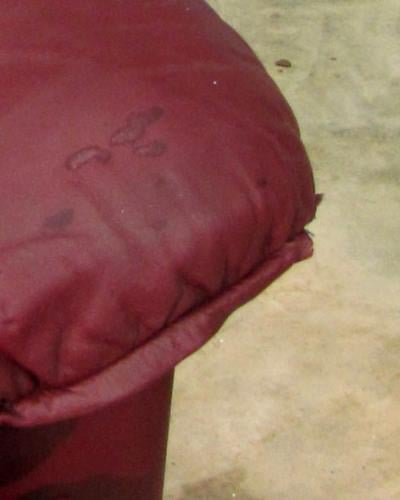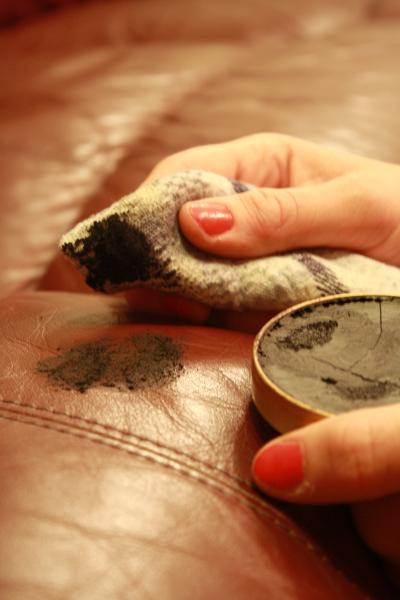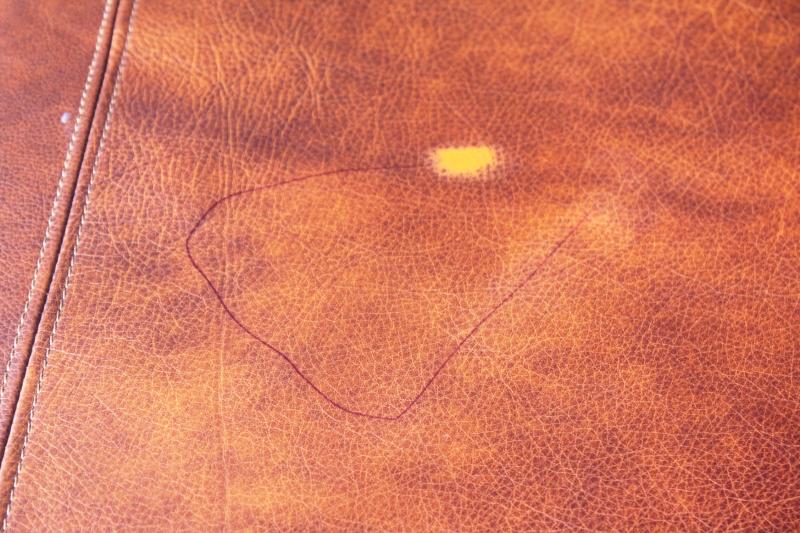8 Old Wives’ Tales About Leather Cleaning and Repair
There are dozens of old wives’ tales about different household products that can be used to DIY clean and repair leather couches, car seats, and other leather products. Heed our advice – don’t use any of the following products on your leather furniture!
We’ve seen countless pieces of furniture ruined by these very things, and we don’t want you to find yourself in the same leather care predicament.

Avoid these substances and products for leather care
Don’t use these materials for your leather care needs—leather is durable and needs to be cared for properly. Always use a dedicated leather care kit for the best results!
1. Olive oil
Lots of people use olive oil to moisten and condition their leather from time to time. It is also used to hide blemishes and dings on couches and chairs. While oil might make your couch look nice right now, you are damaging your furniture irreparably.
The oil will soak into the back side of the leather, eventually filling it up and causing ugly oil spots. Also, while some older leathers require moisture, leather today is tanned to hold in all the moisture it needs.
If you have a piece of leather that you want oiled because you want it to be soft regardless of how it looks (think baseball gloves), then oil may be OK. But it is never advised on any type of high-end or furniture leather.
2. Shoe polish
There are several types of furniture, such as leather, which is very different from the leather used in shoes.
Because leather furniture has different finishes, it will never mix well with shoe polish. The polish will make a gunky mess on your furniture.
3. Beeswax
I’ve seen people try to use beeswax to waterproof leather. This can be a good option for leather work boots, but I do not recommend using it on leather furniture. It can make the leather stiff and waxy to the touch.
4. Hair spray
According to many wives’ tales, hair spray can fix just about anything, from runs in stockings to stains in cotton to marks on leather. Please don’t use it on your leather furniture.
It probably won’t help the stain; it might have alcohol in it (which damages the surface of leather), and it will leave a sticky mess on your furniture. The sticky spot will attract dirt and oils, causing further damage to the place.
5. Markers
People try to use markers to fill in spots on their leather furniture. As the marker will not match your couch exactly, I do not recommend it.
6. Window cleaner
Most people think of window cleaners as one of the mildest cleaners. While it may be mild enough for most household chores, you should never use it on leather furniture.
It contains alcohol that will damage the surface of your leather, leaving it more susceptible to damage.
7. Fingernail polish remover
People use this to try to remove stains from leather, but it also removes the dye, leaving your leather with a bleached-looking spot all around the spot you were originally trying to clean.
8. Disposable cleaning supplies and baby wipes
Most of these contain alcohol; you should never use alcohol on leather. It will break down the protective surface on your leather.
A good rule of thumb
Don’t ever use alcohol or acetone products on leather furniture.
These two things are commonly found in household cleaning products and will damage your leather long-term, breaking down its surface and stripping its color.
DIY leather cleaning tips
Whether you’re trying to care for your leather sofa, leather jacket, new leather, old leather, or anything else, follow this simple tutorial for the best results.
Also, check out this more in-depth guide for cleaning your leather upholstery.
Supplies Needed:
- Mild soap or leather cleaner
- Distilled water
- Soft, clean cloth or sponge
- Leather conditioner (optional)
- Soft brush (optional)
Steps:
- Preparation:
- You can start by removing excess dirt or debris from the leather surface. For this purpose, you can use a soft brush or a dry cloth.
- Test in inconspicuous area:
- Before cleaning the entire surface, test the cleaner or soap solution on a small, inconspicuous area of the leather to ensure it doesn’t damage or discolor it.
- Mix cleaning solution:
- If you’re using a mild soap, mix it with distilled water in a 1:8 ratio (one part soap to eight parts water). If you have a leather cleaner, follow the instructions on the product label for dilution.
- Clean the leather:
- Dip a soft cloth or sponge into the cleaning solution, wring out excess water, and gently wipe the leather surface. Avoid saturating the leather with too much liquid.
- Work in small sections, wiping in a circular motion to lift dirt and stains. Rinse the cloth or sponge frequently and change the cleaning solution if it becomes dirty.
- Dry the leather:
- After cleaning, use a clean, dry cloth to wipe away any excess moisture from the leather. Allow the leather to air dry naturally, away from direct heat sources or sunlight, which can cause the leather to crack or fade.
- Conditioning (optional):
- Once the leather is dehydrated, you may apply a leather conditioner to restore moisture and maintain suppleness. Could you follow the instructions on the conditioner product label for application?
- Buffing (optional):
- After conditioning, you can buff the leather with a soft, dry cloth to enhance its shine and smoothness.
Additional Tips:
- Always gently touch when cleaning leather to avoid scratching or damaging the surface.
- Avoid harsh chemicals, such as bleach or ammonia, as they can strip the natural oils from the leather and cause it to dry.
- You may need to repeat the cleaning process or consider seeking professional assistance for stubborn stains.
- Regularly cleaning and conditioning leather items can help prolong their lifespan and maintain their appearance.
By following these steps and using gentle cleaning products, you can effectively clean leather items at home while preserving their quality and appearance.
DIY leather repair tips
Repairing leather can be trickier than cleaning it, but it’s possible with the right tools and techniques. Common fixes are small rips in leather car seats, patching up scuffs and tears in faux leather and bonded leather products, or even complete leather restoration of a prized piece of furniture (which we highly recommend contacting the professionals to take care of for you.
Supplies Needed:
- Leather repair kit (available at most hardware stores or online)
- Leather cleaner
- Soft cloths
- Fine-grit sandpaper (optional)
- Leather dye or paint (matching the color of your leather)
- Leather conditioner
- Heat gun or hairdryer (for heat-curing repair compounds)
- Cotton swabs
- Masking tape
- Sharp scissors
- Leather filler (if repairing deep cuts or gouges)
- Leather glue (if repairing loose seams or tears)
Steps:
- Clean the leather:
- You can start by cleaning the damaged area of the leather using a leather cleaner. This will remove any dirt, oils, or residues that could interfere with the repair process. Apply the cleaner with a soft cloth and gently wipe the area clean.
- Prepare the surface (if necessary):
- If the damaged area has rough edges or loose fibers, you may need to lightly sand the surface with fine-grit sandpaper to smooth it out. Be gentle to avoid further damage to the leather.
- Apply leather filler (if needed):
- If the leather has deep cuts, gouges, or holes, you’ll need to fill them in with a leather filler. Follow the instructions on the filler product carefully, applying it to the damaged area and smoothing it out with a spatula or your fingers. Allow the filler to dry completely before proceeding.
- Color matching:
- If the damaged area has lost its color, you’ll need to match the color of the surrounding leather using leather dye or paint. To ensure a good match, you can first test the color on a small, inconspicuous area. Then, using a small brush or cotton swab, apply the dye or paint evenly to the damaged area. Allow it to dry completely before proceeding.
- Apply leather repair compound:
- Using a leather repair kit, you can apply the repair compound to the damaged area according to the instructions. This may involve spreading the compound over the injured area, smoothing it out with a spatula, and curing it with a heat gun or hairdryer. Follow the specific instructions provided with your repair kit for best results.
- Condition the leather:
- Once the repair compound is fully cured, apply a leather conditioner to the repaired area to restore moisture and flexibility to the leather. This will help blend the repaired area with the surrounding leather and prevent it from becoming stiff or brittle.
- Final touches:
- Trim any excess repair compound or touch up the repaired area with additional dye or paint to ensure a seamless finish. You can also use masking tape to protect surrounding areas while you work.
Additional Tips:
- Please take your time and follow the instructions carefully to ensure you get the best results.
- Practice on a small, inconspicuous leather area before attempting to repair more extensive or visible damage.
- If you need help with how to proceed or if the damage is extensive, consider seeking professional help from a leather repair specialist.
With patience and attention to detail, you can successfully repair minor damage to leather items and prolong their lifespan.
Stick to the products made by the pros for leather peace of mind
A dedicated, pre-formulated leather cleaner and conditioner/protector will help with cleanliness, durability, water resistance, and every other facet of leather care.
Fibrenew is always here to give you peace of mind regarding all things leather. If you need it, we’ll fix your favorite leather chair right there in your living room.
Please reach out to your local Fibrenew operator for any questions.
And if you’re passionate about leather, maybe a career in leather repair and restoration is the path for you. Check our free Franchise Information Report for everything you need to know.
Rock on!





